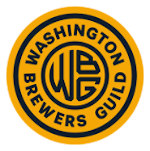In late August, a young man’s fancy turns to thoughts of hops. Last night was Hop Fest at Brouwer’s. Last weekend was the Washington IPA Challenge at the Beveridge Place Pub. A couple weeks ago we were visiting Chris Miller, brewer at Snipes Mountain Brewing in Sunnyside, and he actually told us, “The Simcoes are in early this year.”
‘Tis the season. The harvest is upon us. The ultimate celebration of fresh hops is coming up the first weekend of October, when Yakima hosts the Seventh Annual Fresh Hop Ale Festival.
Washington is responsible for producing the vast majority of the hops grown in the nation. We produce 77% of the nation’s hops and roughly 25% of the world’s hops. In 1982 Bert Grant opened the nation’s first post-prohibition brewpub and helped jump-start the modern craft beer revolution. He was not a Washington native and he could have built his brewery anywhere. He chose Yakima because he wanted to be near the hops.
As a beer-lover in Washington, it’s your duty to know a thing or two about hops. For example, hops grow on bines. While nobody will chastise you for saying, “hop vine,” it is technically a hop bine. Unlike vines, which use tendrils, suckers, and other appendages for attaching themselves, bines have stout stems with stiff hairs to aid in climbing. You live in Washington, the hop basket of the world. You should know things like that.

Only in Washington will you find a school with a curriculum devoted entirely to hops and brew. Last week, Hop Union LLC –the premier provider of specialty hops to the craft and specialty brewing industry– hosted the sixth annual Hop and Brew School in Yakima. Students have the opportunity to get a firsthand look at the production of the product they rely on Hop Union to provide. Most of the pupils are brewers and other beer industry insiders. For a brewer, it is important to understand ingredients as completely as possible. Hop and Brew School helps them do just that.
From fields near Moxee where towering hop bines kiss the sky, to the giant kilns where the precious cones are dried and compressed into pellets, Hop School students learn all they can about hops from the world’s foremost experts. This year’s seminar speakers included Steve Dresler, brewmaster at the Sierra Nevada Brewing Co., and George Drexlor, manager of technical sales at Joh. Barth and Sohn, Germany’s leader in hop trading and processing. Seminars focused on topics, such as the state of the global hop supply and the industry’s current surplus problem. Hop and Brew School is probably a tad too geeky for most of us.
This is all pretty serious stuff, but Hop and Brew School is not all business. Brewers from across the country attend Hop and Brew School and most of them bring product to sample with their fellow students. Each day concludes with a barbeque dinner, which provides a comfortable way for people to meet, socialize, make new contacts, and swap brews.
Hop and Brew School is an example of the hop culture that we take for granted around here. “The great thing about American beer is the great diversity,” George Drexlor told the Yakima Herald. “We don’t have such a hops-growing scene in Germany at the moment.”
Saturday, October 3rd is an opportunity for us normal beer lovers to celebrate the harvest. The Fresh Hop Ale Festival in Yakima features beer from 16 craft brewers. In addition to being a beer fest, it is also a fresh hop ale competition.
For a brew to be considered “fresh hop ale” for the festival, it must be produced with hops that were picked no longer than 24 hours prior to brewing. Local and expert judges meet just prior to the festival to rate the beers on appearance, aroma, taste, mouthfeel, and aftertaste, using the Beer Judge Certicfication Program (BJCP) criteria. Judges will determine a first, second, and third place beer. A “most pours” award crowns the crowd favorite after the event.
The Fresh Hop Ale Festival takes place on Saturday, October 3rd at the Millennium Arts Plaza in downtown Yakima. The event runs from 6:00 – 11:00 PM. For more information, visit the festival Web site at http://www.freshhopalefestival.com.
5 thoughts on “It's All About the Hops – Fresh Hop Fest and More”
Comments are closed.


































> “the industry’s current surplus problem.”
Can you elaborate on this? 2 years ago we had a shortage, now we have a surplus? Does that mean hop prices will be lower after the harvest this year?
> “the industry’s current surplus problem.”
Can you elaborate on this? 2 years ago we had a shortage, now we have a surplus? Does that mean hop prices will be lower after the harvest this year?
Good question, Patrick. There were reasons for the shortage a couple years ago, some better publicized than others. I won’t go into that. But what does this surplus mean? IIf nobody posts a reply to your comment, I will certainly let you know what “hop surplus” means as soon as I get more information.
For futher info:
http://www.barthhaasgroup.com/cmsdk/content/bhg/news/2008%20Barth%20Report%20English.pdf
see what surplus means:
more hops than demand
Wow, reading through that Barth Report made me understand why there is such a thing as Hop School. A lot of information. One thing that stood out to me, on page 9…
“All the assumptions made a year ago regarding beer consumption and hop demand are now unfounded. A large part of the acreage expansion carried out in 2008 in the USA in particular in response to demand from the brewing industry is now no longer needed.”
I still can’t pretend to understand how all of this will affect prices. My gut instinct is that it will not affect prices in any way that will be noticeable to the consumer. But, I haven’t been to Hop School.